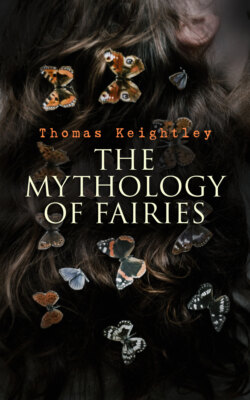Читать книгу The Mythology of Fairies - Thomas Keightley - Страница 14
На сайте Литреса книга снята с продажи.
THE ALFAR.
ОглавлениеTable of Contents
Ther ro meth Alfum.
Brynhildar Quida.
Those are with the Alfs.
In the prose Edda, Ganglar inquires what other cities beside that in which the Nornir dwelt were by the Urdar fount, under the Ash Yggdrasil.99 Hár replies,
"There are many fair cities there. There is the city which is called Alf-heim, where dwelleth the people that is called Liosálfar (Light Alfs). But the Döckálfar (Dark Alfs) dwell below under ground, and are unlike them in appearance, and still more unlike in actions. The Liosálfar are whiter than the sun in appearance, but the Döckálfar are blacker than pitch."100
The Nornir, the Parcæ, or Destinies of Scandinavian mythology, are closely connected with the Alfar.
"Many fair cities are there in Heaven," says Hár, "and the divine protection is over all. There standeth a city under the ash near the spring, and out of its halls came three maids, who are thus named, Udr, Verthandi, Skulld (Past, Present, Future). These maids shape the life of man. We call them Nornir. But there are many Nornir; those who come to each child that is born, to shape its life, are of the race of the gods; but others are of the race of the Alfs; and the third of the race of dwarfs. As is here expressed,
Sundry children deem I
The Nornir to be—the same
Race they have not.
Some are of Æser-kin,
Some are of Alf-kin,
Some are the daughters of Dualin." (i.e. of the Dwarfs.)
"Then," said Ganglar, "if the Nornir direct the future destiny of men, they shape it very unequally. Some have a good life and rich, but some have little wealth and praise, some long life, some short." "The good Nornir, and well descended," says Hár, "shape a good life; but as to those who meet with misfortune, it is caused by the malignant Nornir."
These Nornir bear a remarkable resemblance to the classical Parcæ and to the fairies of romance. They are all alike represented as assisting at the birth of eminent personages, as bestowing gifts either good or evil, and as foretelling the future fortune of the being that has just entered on existence.101 This attribute of the fairies may have been derived from either the north or the south, but certainly these did not borrow from each other.
Of the origin of the word Alf nothing satisfactory is to be found. Some think it is akin to the Latin albus, white; others, to alpes, Alps, mountains. There is also supposed to be some mysterious connexion between it and the word Elf, or Elv, signifying water in the northern languages; an analogy which has been thought to correspond with that between the Latin Nympha and Lympha. Both relations, however, are perhaps rather fanciful than just. Of the derivation of Alf, as just observed, we know nothing certain,102 and the original meaning of Nympha would appear to be a new-married woman,103 and thence a marriageable young woman; and it was applied to the supposed inhabitants of the mountains, seas, and streams, on the same principle that the northern nations gave them the appellation of men and women, that is, from their imagined resemblance to the human form.
Whatever its origin, the word Alf has continued till the present day in all the Teutonic languages. The Danes have Elv, pl. Elve; the Swedes, Elf pl. Elfvar m. Elfvor f.; and the words Elf-dans and Elf-blæst, together with Olof and other proper names, are derived from them. The Germans call the nightmare Alp; and in their old poems we meet with Elbe and Elbinne, and Elbisch occurs in them in the bad sense of elvish of Chaucer and our old romancers; and a number of proper names, such as Alprecht, Alphart, Alpinc, Alpwin,104 were formed from it, undoubtedly before it got its present ill sense.105 In the Anglo-Saxon, Æl, or Ælen, with its feminine and plural, frequently occurs. The Oreas, Naias, and Hamodryas of the Greeks and Romans are rendered in an Anglo-Saxon glossary by un-ælen, ǽ-ælen, and el-ælen.106 Æl is a component part of the proper names Ælfred and Ælfric; and the author of the poem of Judith says that his heroine was Æl-eine (Elf-sheen), bright or fair as an elf. But of the character and acts of the elfs no traditions have been preserved in Anglo-Saxon literature. In the English language, Elf, Elves, and their derivatives are to be found in every period, from its first formation down to this present time.
